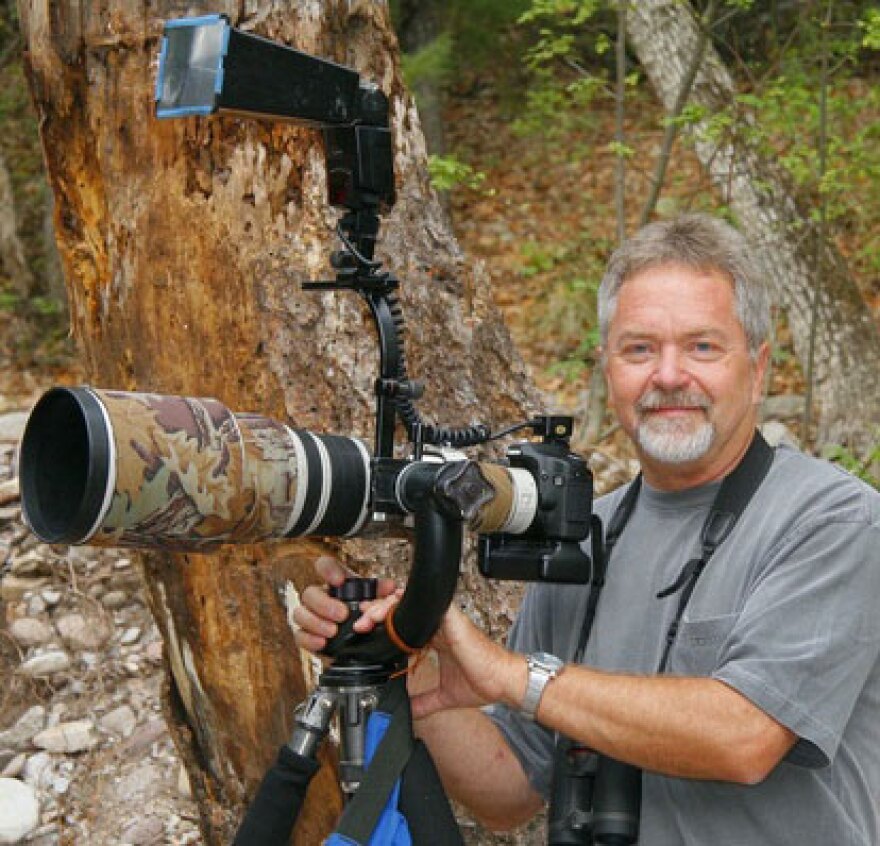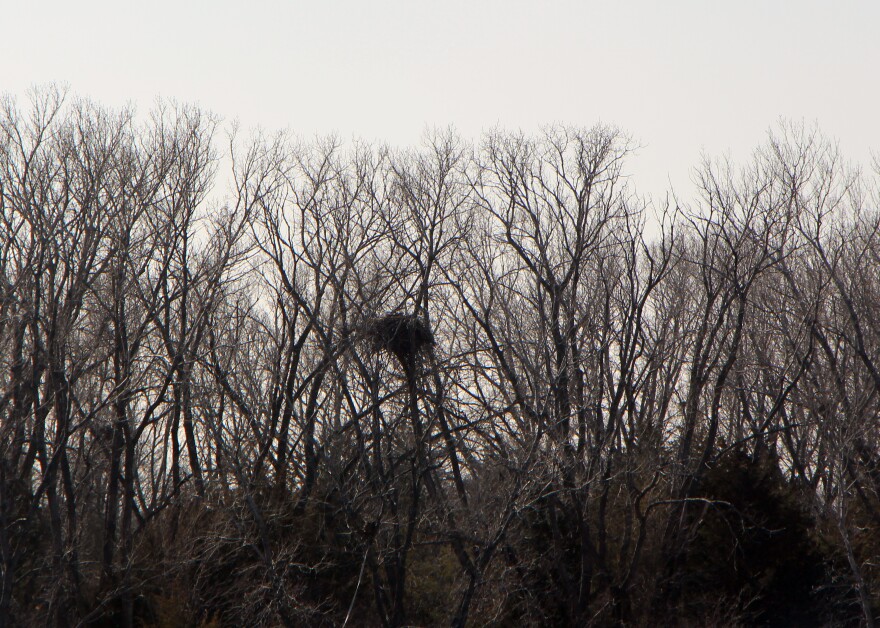As many as 2,500 bald eagles migrate to Kansas every year, and a few of them have taken up residence in Sedgwick County.
KMUW’s Abigail Wilson has more about the birds whose increasing population in the U.S. has made them a success story for endangered species.

A giant nest of tangled branches and twigs sits 50 feet high in a stand of cottonwood trees near a lake south of downtown Wichita. The nest is home to a pair of bald eagles. Bob Gress has taken a special interest in these birds, both personally and professionally, and is the former director of the Great Plains Nature Center. The nest is a pretty good distance away, about a quarter mile, but this is as close as we get, as Gress’s main concern is to not disturb the birds. He uses binoculars to see if he can spot a female eagle as she incubates her eggs. He says he sees the current population of eagles as a success story.
"It’s a story of what we as people can do if we’re willing to try to help a species comeback,” Gress says.
And while the species has rebounded and is no longer on the endangered species list, they’re still protected by law. But those protections aren’t always honored. Just last week, an eagle was shot north of Newton in Marion County.

Wildlife biologist Charlie Cope shares the binoculars with Bob Gress; he often checks out bald eagles and the waterfowl at the lake.
“The people who killed the eagle...there’s no season on it; there’s no permit that you can buy to kill it unless you go through the federal process. And that wasn’t done. So they’re basically criminals.”
The Migratory Bird Treaty Act and the Bald and Golden Eagle Protection Act prohibit killing, selling or otherwise harming eagles, their nests, or eggs.
Cope says that a nest near that area was on his radar, but there’s no way to know exactly where the slain bird was nesting or where it may have come from. He says he’s seen the pair of eagles we’re watching return each year for about five years. Area homeowners called the Division of Wildlife and brought it to their attention.

"They called us and said we’ve got eagles here building a structure," Cope says. "And of course, I’m focused on the water because that’s where the ducks and geese are, not looking up in the trees. So there’s a good probability I might not have seen it unless I saw one swoop down to check the ducks and the waterfowl, the geese, to see if they were paying attention looking for food.”

Bald eagles typically migrate to Kansas and surrounding states from the northern U.S. in the winter months, but this pair decided to stay year round. Cope says it’s anyone’s guess as to why they chose to remain in this area.
"If you could figure out why wildlife does different things that wildlife does, you could buy lottery tickets and win all the time," he says. "Nobody knows other than it’s a good habitat. But there’s good habitat at Cheney and El Dorado and all of the other big reservoirs.
And while their habitat is here, Cope says there were no records of bald eagles nesting anywhere in Kansas before 1989. The first nest was discovered that winter at Clinton Lake near Lawrence.
“In Kansas in ’89 we started out with the one nest, and now we’ve had a total of 105 known nesting territories," he says. "Last year we had 85 active known nesting territories and of those 85, 41 were monitored close enough to know that we produced 76 eaglets."
He says he’s seen a steady increase in the number of eagles in the Wichita area since 2009.
“We seem to be gaining a nest or two every year, and they’ve been real successful,” Cope says.
And although the birds are breeding successfully and increasing in number now, that hasn’t always been the case. Bald eagles were declared an endangered species in 1967. At that time, there were only 450 nesting pairs in the continental United States. Biologists blamed a loss of habitat, shooting, trapping and the heavy use of pesticides such as DDT. Eagles began making a comeback in the late 1980’s. They were removed from the endangered species list in 2007.

Cope says a process called “hacking” also helped increase the population.
“They’d go to nests like down in Florida, areas that had productive eagles, and collect the eggs and bring them up to Oklahoma, to the Sutton Research Center, and hatch the eggs and incubate them," he says. "Then they’d take them out to hack sites, and people would feed them until they could fledge and fly away. And they did it [in such a way that] the eagles didn’t know that they were being fed by humans.”

He says the hacking helped to expand the population more quickly than would have happened if the eagles made a come back on their own.
“It would have taken a lot longer if we had not helped," Cope says. "Now, they were so tenuous of a population, would they have survived? I don’t know, but I think so. The protection act aspect probably helped a lot.”
Both men agree that bringing a species back from the brink of extinction is a big deal, and having the eagles here locally will only help bring public awareness and strengthen their growing numbers.
“The bald eagles are a reminder to us that if we want to do similar things to other wildlife, that the precedence is there, and the example is there and we know it can be done if we’re willing to take the efforts to do it,” Gress says.
The U.S. Fish and Wildlife Service and the Kansas Department of Wildlife, Parks and Tourism are still investigating the shooting of the eagle near Marion Reservoir.
--
To contact KMUW News or to send in a news tip, reach us at news@kmuw.org.
Follow Abigail Wilson on Twitter, @AbigailKMUW


